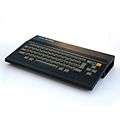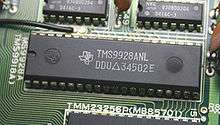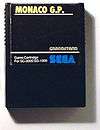SG-1000
|
| |
 | |
| Manufacturer | Sega |
|---|---|
| Type | Home video game console |
| Generation | Third generation |
| Release date |
SG-1000
|
| Discontinued |
SG-1000
|
| Media | ROM cartridge, cassette tape, Sega Card |
| CPU | Zilog Z80 @ 3.58 MHz |
| Memory | 1 KB RAM |
| Display | 256 × 192 resolution, 16 colors, 32 on-screen sprites |
| Graphics | Texas Instruments TMS9928A |
| Sound | Texas Instruments SN76489 |
| Successor | Master System |
The SG-1000,[lower-alpha 1] also known as the Sega Computer Video Game SG-1000, is a home video game console manufactured by Sega and released in Japan, Australia, and other regions. It was Sega's first entry into the home video game hardware business, and provided the basis for the more successful Master System. Introduced in 1983, the SG-1000 was released on the same day that Nintendo released the Family Computer in Japan. The SG-1000 was released in several forms, including the SC-3000 computer and the redesigned SG-1000 II,[lower-alpha 2] also known as the Mark II, released in 1984.
Developed in response to a downturn in arcades in 1982, the SG-1000 was created on the advice of Hayao Nakayama, president of Sega Enterprises, Ltd. Shortly after the release, Sega Enterprises was sold to CSK Corporation, which was followed by the release of the SG-1000 II. The SG-1000 and its later models support the library of 68 standard ROM cartridge games and 29 Sega Card games, all of which are fully compatible with the Mark III and the Master System. Due to the release of the Famicom, and the number of consoles present in the market at the time, the SG-1000 was not commercially successful.
History
 |
 |
 |
 |
In the early 1980s, Sega Enterprises, Inc., then a subsidiary of Gulf and Western, was one of the top five arcade game manufacturers active in the United States, as company revenues rose to $214 million.[1] A downturn in the arcade business starting in 1982 seriously hurt the company, leading Gulf and Western to sell its North American arcade manufacturing organization and the licensing rights for its arcade games to Bally Manufacturing.[2][3] The company retained Sega's North American R&D operation, as well as its Japanese subsidiary, Sega Enterprises, Ltd. With its arcade business in decline, Gulf and Western executives turned to Sega Enterprises, Ltd.'s president, Hayao Nakayama, for advice on how to proceed. Nakayama advocated that the company leverage its hardware expertise gained through years working in the arcade industry to move into the home console market in Japan, which was in its infancy at the time.[4] Nakayama received permission to proceed, leading to the release of Sega's first home video game system, the SG-1000.[5] To keep costs down while ensuring sufficient longevity, Sega opted to create the platform from popular off-the-shelf components.[6] The first model to be developed was the SC-3000, a computer version with a built-in keyboard, but when Sega learned of Nintendo's plans to release a games-only console, they began developing the SG-1000 alongside the SC-3000.[6]
The SG-1000 was first released in Japan on July 15, 1983, at JP¥15,000.[7] It was released on the same day as Nintendo launched the Family Computer (Famicom) in Japan.[5][8] It was released simultaneously with the SC-3000,[5][7][9] also known as the Sega Personal Computer SC-3000,[10] as well as the upgraded SC-3000H.[11] Though Sega themselves only released the SG-1000 in Japan, rebranded versions were released in several other markets worldwide. Released at nearly the same time as the Japanese version, the SG-1000 was released in Australia through John Sands Electronics[5] and in New Zealand by Grandstand Leisure.[6] The console also saw a release in Italy and Spain,[12] but was not released in the larger video game markets of the United States, United Kingdom, or Germany.[8] Despite this, an unauthorized clone system known as the Telegames Personal Arcade was produced and made available in the United States and Taiwan, and is able to play SG-1000 and ColecoVision games.[5] An additional release of the SG-1000 in Taiwan was done by Aaronix.[6] The console enjoyed a brief period of popularity in Taiwan before the market was taken over by cheaper Famicom clones.[13]
The SG-1000's launch did not prove to be successful.[12] The three launch games, all of which were ported from Sega's VIC dual-arcade board, lacked the name recognition of Famicom launch games Donkey Kong, Donkey Kong Jr., and Popeye.[6] Due in part to the SG-1000's steadier stream of releases (21 SG-1000 games by the end of 1983, as compared to only 9 Famicom games), and in part to a recall on Famicom units necessitated by a faulty circuit, the SG-1000 chalked up 160,000 units in sales in 1983, far exceeding Sega's projection of 50,000 units.[6] Shortly after launch, Gulf and Western began to divest itself of its non-core businesses after the death of company founder Charles Bluhdorn,[14] so Nakayama and former Sega CEO David Rosen arranged a management buyout of the Japanese subsidiary in 1984 with financial backing from CSK Corporation, a prominent Japanese software company. Nakayama was then installed as CEO of the new Sega Enterprises, Ltd.[15] Following the buyout, Sega released another console, the SG-1000 II, on July 31, 1984[9][12] at JP¥15,000.[16] It featured hardware tweaks from the original model, including detachable controllers[5] and the ability to play Sega Card games.[12] The lead designer of consumer hardware development at Sega, Hideki Sato, disliked the original cartridges, saying they looked like "small black tombstones" when inserted in the console, and later remarked that his proudest achievement of the SG-1000 era was replacing them with the "cheerier", pocket-sized Sega Cards.[6] Sega also employed popular owarai comedy duo Tunnels to provide celebrity endorsement for the console.[6]
By 1984, the Famicom's success began to outpace the SG-1000. The Famicom had more advanced hardware, allowing it to perform smoother scrolling and more colorful sprites, and Nintendo boosted its games library by courting third-party developers, whereas Sega was less than eager to collaborate with the same companies they were competing with in arcades.[6] The SG-1000 was also coming up against game consoles from companies including Tomy and Bandai.[5] This would result in the release of the Sega Mark III in Japan in 1985, which later became the Master System worldwide.[12] The last cartridge released was Portrait of Loretta on February 18, 1987.[17] In 2006, the GameTap subscription gaming service added an emulator of the SG-1000, and several playable titles.[18]
Technical specifications

The SG-1000 is powered by an 8-bit Zilog Z80 central processing unit running at 3.58 MHz for the SG-1000 and SG-1000 II,[19][20] and at 4 MHz for the SC-3000.[21] Its video processor is a Texas Instruments TMS9928A, capable of displaying up to 16 colors, and its sound processor is a Texas Instruments SN76489. All three chips were also used in the ColecoVision.[5] The system includes 8 kbit (1 KB) of random access memory (RAM)[19] The controller is hardwired to the system in the original model, and detachable in the SG-1000 II. Video and audio output are supplied through an RF switch.[5] Power is supplied through a 9 V DC connector connected to an AC adapter.[19][20][21]
Several peripherals exist for the SG-1000 series. Available at ¥13,800 at its time of release, the SK-1100 keyboard connects through the expansion slot and is compatible with all models.[22] Multiple controllers were created, including the SJ-200 joystick attached to the SG-1000, and the SJ-150 joypad, made for use with the SG-1000 II. A racing wheel known as the SH-400 was made for use with games such as Monaco GP.[23] The C-1000 Card Catcher, sold at ¥1,000, allowing players to play Sega Card titles.[24] Additional accessories existed solely for use with the SC-3000, including the SR-1000 cassette deck,[25] the SP-400 4-color plotter printer,[26] and the SF-7000 expansion device which adds a floppy disk drive and additional memory.[27]
Game library

The SG-1000's game library comprises 68 standard cartridge releases and 29 Sega Card releases. All games play on each model, although 26 cartridge releases require the keyboard accessory or the SC-3000.[17] All titles are fully compatible with the Mark III and Master System. Titles for the system include Flicky, Congo Bongo, Sega-Galaga, and Girl's Garden, the first video game programmed by Sonic the Hedgehog developer Yuji Naka. The library included licensed titles, such as Golgo 13. Packaging and game manuals came with both Japanese and English text until 1984, when manuals were switched to Japanese only and the size of the cartridge box was reduced.[5]
Many of the games for the console were arcade ports or clones of arcade games; the SG-1000 did not contain games with recognizable characters from Sega's video game franchises.[8] Comparisons have been made of the appearance of SG-1000 games to those released for the ColecoVision, and the graphics have been criticized in light of the simultaneous release of the Famicom. The controls have been criticized for lack of responsiveness; writing for Wired, reviewer Chris Kohler says of Flicky, "the jumping control is so terrible that getting back up to the exit is insanely difficult."[5]
Reception and legacy
The SG-1000 made little impact on the video game industry, but has been recognized for being Sega's first video game console. Retro Gamer writer Damien McFerran said it was an "abject failure", but called it and the SG-1000 II "the Japanese forefathers of the Master System".[12] Writing for Wired, Chris Kohler criticized the poor response of the controller's joystick and the lack of an RCA output. He said the release timing hurt its success; "[al]though its graphics were of better quality than most consoles on the market, it had the bad luck to be released in the same month as Nintendo's world-changing Famicom, which had killer apps like Donkey Kong and could run circles around Sega's hardware."[5] Of its legacy, Kohler said, "Few have heard of it, even fewer have played it, and the games weren't that great anyway."[5] By contrast, Luke Plunkett of Kotaku recognized that "while all this makes it sound like the SG-1000 was a bit of a misfire, it was still important in the development of Sega's home console business."[8]
See also
Notes
References
- ↑ Brandt, Richard; Gross, Neil (February 1994). "Sega!". Businessweek. Archived from the original on December 3, 2013. Retrieved October 10, 2013.
- ↑ Pollack, Andrew (October 24, 1982). "What's New In Video Games; Taking the Zing Out of the Arcade Boom". New York Times. Archived from the original on December 19, 2013. Retrieved November 27, 2013.
- ↑ "The Bottom Line". Miami Herald – via NewsBank (subscription required) . August 27, 1983. Archived from the original on November 10, 2013. Retrieved October 10, 2013.
- ↑ Battelle, John (December 1993). "The Next Level: Sega's Plans for World Domination". Wired. Condé Nast Publications. Archived from the original on May 2, 2012. Retrieved October 9, 2013.
- 1 2 3 4 5 6 7 8 9 10 11 12 13 Kohler, Chris (October 2009). "Playing the SG-1000, Sega's First Game Machine". Wired Magazine's online site. Archived from the original on January 1, 2014. Retrieved October 5, 2009.
- 1 2 3 4 5 6 7 8 9 Marley, Scott (December 2016). "SG-1000". Retro Gamer. No. 163. Future Publishing. pp. 56–61.
- 1 2 "SG-1000" (in Japanese). Sega Corporation. Archived from the original on July 16, 2014. Retrieved February 12, 2014.
- 1 2 3 4 Plunkett, Luke (January 19, 2017). "The Story of Sega's First Console, Which Was Not The Master System". Kotaku. Gizmodo Media Group. Archived from the original on March 6, 2017. Retrieved March 3, 2017.
- 1 2 Gamer's High! Futabasha Super Mook (in Japanese). Futabasha. 2015. p. 54. ISBN 978-4-575-45554-0.
- ↑ "SC-3000" (in Japanese). Sega Corporation. Archived from the original on July 16, 2014. Retrieved February 15, 2013.
- ↑ "SC-3000H" (in Japanese). Sega Corporation. Archived from the original on February 22, 2014. Retrieved February 15, 2013.
- 1 2 3 4 5 6 McFerran, Damien. "Retroinspection: Master System". Retro Gamer. Imagine Publishing (44): 48–53.
- ↑ Marley, Scott (December 2016). "The Rare Jewels from Taiwan...". Retro Gamer. No. 163. Future Publishing. p. 61.
- ↑ "G&W Wins Cheers $1 Billion Spinoff Set". Miami Herald – via NewsBank (subscription required) . August 16, 1983. Archived from the original on November 10, 2013. Retrieved October 10, 2013.
- ↑ Kent, Steven L. (2001). "The Birth of Sega". The Ultimate History of Video Games: The Story Behind the Craze that Touched our Lives and Changed the World. Roseville, California: Prima Publishing. p. 343. ISBN 0-7615-3643-4.
- ↑ "SG-1000 II" (in Japanese). Sega Corporation. Archived from the original on February 9, 2013. Retrieved February 15, 2013.
- 1 2 "SG-1000" (in Japanese). Sega Corporation. Archived from the original on February 9, 2013. Retrieved February 12, 2014.
- ↑ "GameTap Celebrates Sonic's 15th Anniversary With Rare Content From Import-Only Console, Lock-On Genesis Games, And New TV-On-The-Web Programming". GamesIndustry International. Gamer Network. June 23, 2006. Archived from the original on February 22, 2014. Retrieved February 27, 2014.
- 1 2 3 "SG-1000 Technical specifications" (in Japanese). Sega Corporation. Archived from the original on December 3, 2013. Retrieved February 12, 2014.
- 1 2 "SG-1000 II Technical specifications" (in Japanese). Sega Corporation. Archived from the original on February 22, 2014. Retrieved February 12, 2014.
- 1 2 "SC-3000 Technical specifications" (in Japanese). Sega Corporation. Archived from the original on October 6, 2014. Retrieved February 12, 2014.
- ↑ "SK-1100" (in Japanese). Sega Corporation. Archived from the original on February 22, 2014. Retrieved February 12, 2014.
- ↑ "SG-1000 controllers" (in Japanese). Sega Corporation. Archived from the original on February 22, 2014. Retrieved February 12, 2014.
- ↑ "Card catcher" (in Japanese). Sega Corporation. Archived from the original on February 22, 2014. Retrieved February 12, 2014.
- ↑ "SR-1000" (in Japanese). Sega Corporation. Archived from the original on February 22, 2014. Retrieved February 12, 2014.
- ↑ "SP-400" (in Japanese). Sega Corporation. Archived from the original on February 22, 2014. Retrieved February 12, 2014.
- ↑ "SF-7000" (in Japanese). Sega Corporation. Archived from the original on February 22, 2014. Retrieved February 12, 2014.
External links

